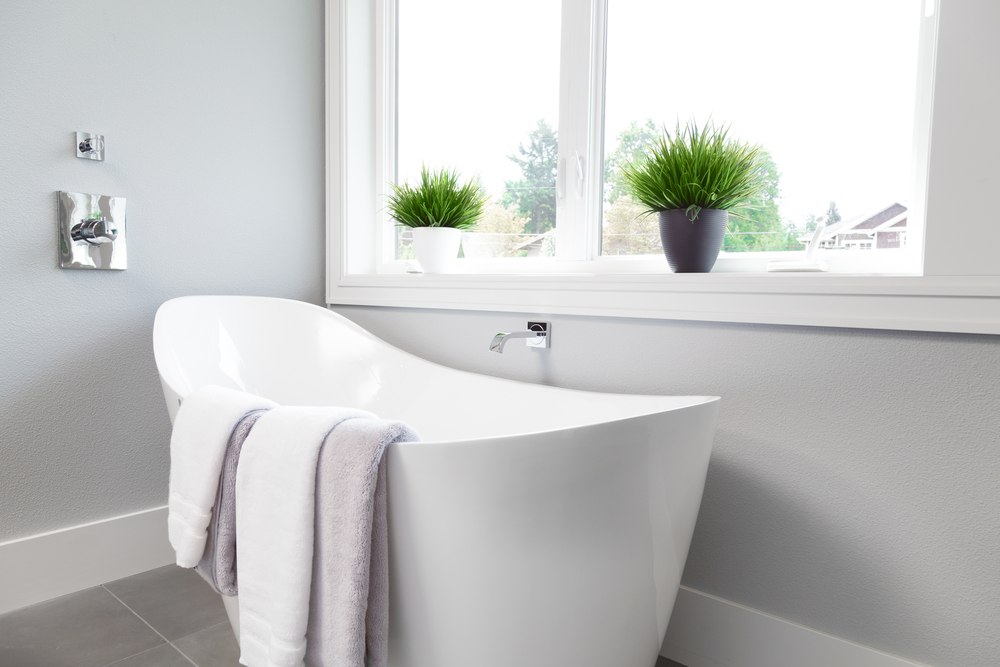
March 2, 2024
How to Properly Clean a Bathtub
There’s nothing better than a hot bath after a long day to help you relax and unwind. But if your bathtub isn’t clean, that relaxing soak can just add to your stress. Thankfully, it’s not difficult to transform your tub from dingy to jaw-dropping.
When you learn how to clean your tub properly, the once-dreaded chore will turn into a simple process you can do once a month. Keep reading to discover the reasons your bathtub stays so dirty, the benefits of a clean tub, and the process of keeping your tub clean and welcoming for your entire family.
Why Do Bathtubs Get So Dirty?
The bathtub is one of the most visited areas of your home, so it’s important to maintain it. But if you’re using your bathtub to get clean, why does it stay so dirty?
Using your shower and bathtub regularly is bound to result in dirt and grime sticking to your walls and floor, especially if you have kids or pets. In New York City, there’s no telling what you’ll get into or who you’ll come into contact with during the day. The tub is the place where you can let the day wash away (literally), but the tub itself could hang on to some of that dirt and grime.
Hard water can result in rust stains, and iron deposits in your water can leave behind stains as well. Even if your tub is clean, rust stains can make the surface appear dirty. Limescale buildup can make your tub look dirty as well. Add that to the soap residue, skin cells, and bacteria deposited into your tub every day, and it’s suddenly easy to understand why your tub doesn’t seem to stay clean.
But the tub itself may not be the only place you find dirt. Your shower curtain can also contribute. Research has shown that shower curtains can harbor a wide range of pathogens and biofilms (which you may know as “soap scum”). If you’re not cleaning your tub regularly, these pathogens will only continue to build up and present greater health risks to you and your family.
Health Benefits of a Clean Tub
When you’re bathing in a clean tub, you can rest assured that you’re truly getting clean when you wash up. A clean bathtub is free of mold and harmful bacteria, so you’ll have an easier time staying healthy inside and out. Keeping your tub clean can also prevent the buildup of mold and mildew, contributing to a cleaner home overall.
Cleaning your tub (and your bathroom in general) has a huge impact on your mental health as well. Whether you’re taking a relaxing bath at the end of the day or are getting ready in the morning for a big day in the city, a clean tub can put you at ease and help you get rid of stress.
If you or a family member is immunocompromised, having a clean bathtub is particularly important. These individuals are at an increased risk of illness and may develop infections if skin breaks (like cuts or scabs) are exposed to bacteria in the bathroom. A bathtub filled with dirt and bacteria could also harm those with asthma or other respiratory conditions. So, keeping your tub clean will let your loved ones use your bathroom without worry.

How to Clean Your Tub
Cleaning your tub properly isn’t a hard process, and when you integrate it into your regular cleaning routine, it becomes easier every time. Ideally, you should be cleaning your bathtub regularly (about once a week) and performing a deep clean once a month.
Before you start cleaning your tub, prepare the space. Take out any soap, bath toys, or other items that live in your tub and clean them individually. You’ll also want to grab a clean towel and fold it a couple of times, making a soft surface for you to kneel on when you’re scrubbing the floor of the tub. Make sure your room is properly ventilated before you start working with chemicals.
Start by pouring hot water all over the tub before coating the surface with baking soda. If your tub is particularly dirty, you can use a commercial tub-and-tile cleaner to tackle stains and break through any stubborn dirt. Scrub the tub using a combination of hot water and dish soap (with a stiff nylon brush or a scrub sponge) before rinsing with clean water.
To clean your drain, pour four tablespoons of baking soda down the drain and follow it with two cups of vinegar. When the drain stops bubbling, flush it with boiling water. The combination of baking soda and vinegar will break down clogs and help your drain work more efficiently. Consider using a mesh drain catcher to collect hair and prevent your drain from slowing in the future.
Tough mold or mildew stains can be tackled with a combination of baking soda and water. Add four tablespoons of bleach to a spray bottle and fill it with hot water. Spray your cleaning solution onto the stained areas of the tub and let it soak. In the meantime, you can sprinkle baking soda all over the tub and continue the cleaning process as described above.
Scrub corners and crevices with a toothbrush to remove soap scum and other buildup without damaging the tub’s surface.
When you’re all done cleaning, don’t forget to dry! Use a clean cloth to dry the faucet, drain, and handles to prevent water spots and keep your surfaces shiny and pristine.
To maintain a clean tub, change your shower curtain and/or liner regularly and dry any products or items that sit on your tub’s edges, such as shampoos and soaps. Excess moisture can attract bacteria or leave behind stains, negating all the hard work you just did!
Tips for Different Tub Types
The cleaning process we’ve outlined is a general guideline for tubs of all kinds. However, bathtubs of different materials may require slightly different methods of cleaning.
If you have a fiberglass tub, use a soft cloth to prevent scratches. Vinegar diluted with water will easily remove almost any stain. For tougher stains, soak a towel with vinegar and baking soda or hydrogen peroxide. Put the towel on top of the stain and let it sit for no more than an hour before rinsing.
Acrylic bathtubs are easy to clean with baking soda or a water/vinegar mixture. Bristle brushes are helpful for cleaning corners and edges, but don’t apply too much pressure to avoid damaging the tub’s surface.
Porcelain-enameled tubs look sleek and elegant in any New York City home or apartment, but they require a bit more attention than some other tub types. Only use gentle cleaners and tools when cleaning. Warm water combined with ammonia and baking soda can easily tackle any stains.
Stone-resin tubs are both beautiful and durable, and they can last for years if properly maintained. Dishwasher detergent and water are ideal for cleaning stone-resin tubs. Be sure to rinse and dry the tub completely to prevent streaks.
If you’re ever in doubt, the best course of action is to clean gently. You can always clean a surface or scrub at a stain multiple times, but if you’re too rough, you run the risk of permanently damaging your tub’s surface.
Working with White Glove Cleaner
Cleaning the bathtub might not be your favorite chore, but it’s important when it comes to the overall look and feel of your home or apartment. When it comes to maintaining a clean and welcoming space, White Glove Cleaner can help.
White Glove Cleaner is a commercial and residential cleaning company in NYC serving all five boroughs. Our team provides a wide array of one-time cleaning services as well as recurring services on a weekly, bi-weekly, or monthly basis. We’re proud to clean spaces big and small and help you maintain a space you’re proud to be in.
Our team members are individually vetted and background checked to ensure the utmost professionalism. We save you time and money by providing our own cleaning solutions and equipment, but if you have a certain product you prefer, we’re happy to follow your lead. Additionally, we offer a “green” cleaning service that utilizes hypoallergenic cleaners, ideal for those with allergies or sensitivities and safe for households with kids or pets.
White Glove Cleaner provides several specialty services including move-in/move-out cleaning, deep cleaning, and more. Contact us today to learn more about all of our offerings and to schedule your next cleaning today!
